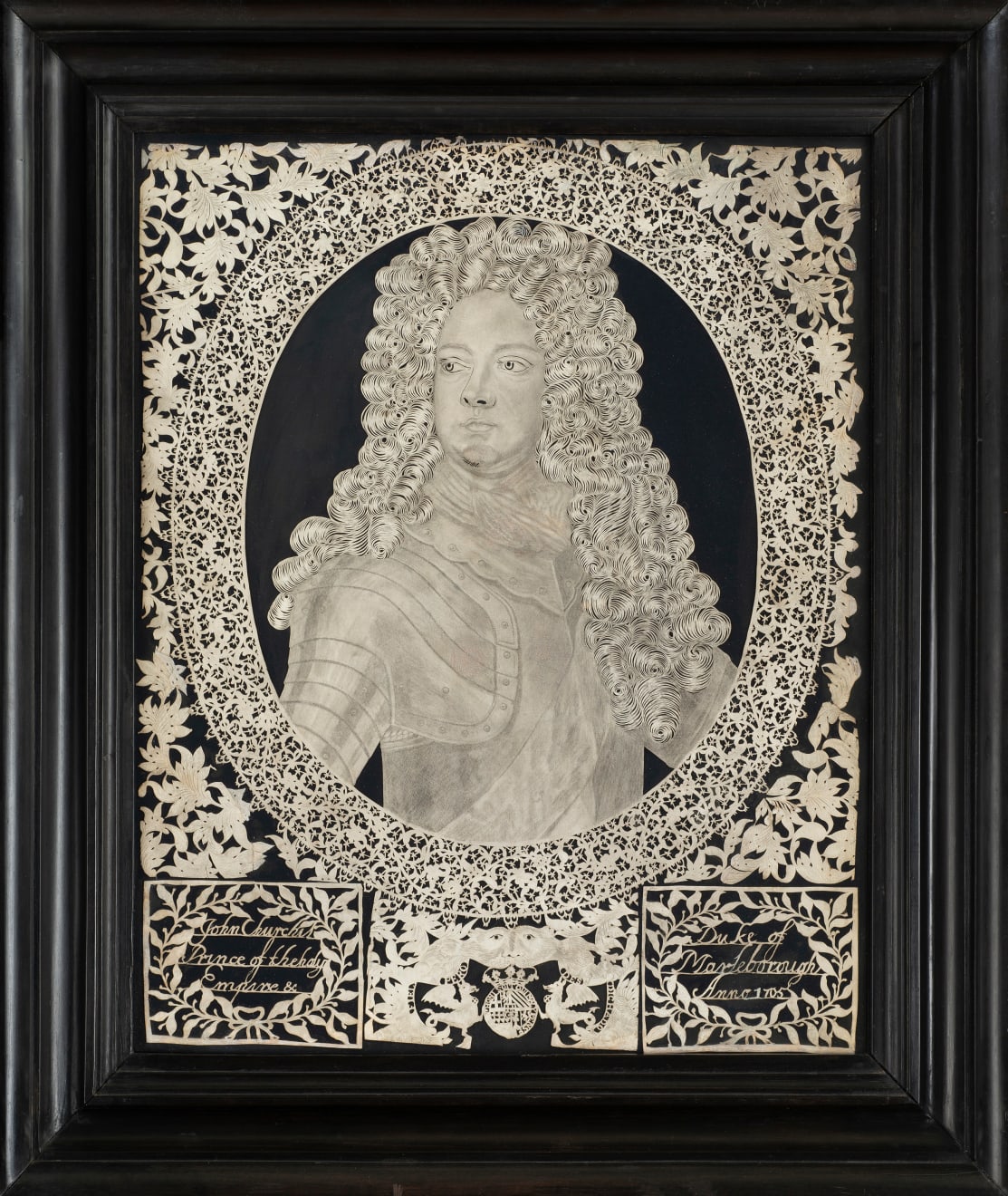18th Century Cut Vellum Portrait of John Churchill, 1st Duke of Marlborough
15 ¼ x 12 ¼ in
Further images
Provenance
Sold Sotheby's New York, October 13th, 1994, lot 93
With Jeremy Ltd., London
The property of a Nobleman
The pencil and cut vellum bust in an oval cut paper frame and foliate spandrels, the lower section with a crest and panels with cut text 'John Churchill, Prince of the holy Empire & Duke of Marleborough (sic) Anno 1705', in a glazed ebonised frame.
This picture is created after a mezzotint of John Churchill, Duke of Marlborough made by John Smith, circa 1703, after an original painting by Sir Godfrey Kneller. A similar first state mezzotint dated 1703 by Smith is in the British Museum (ref. Bb,1.131).
Cut paper pictures: were executed predominantly by women from the late 17th century for royalty and the upper classes and originated in folk art. Small scissors, knives and pins were used to create the delicate pictures. Portraits, devotional pieces, landscapes and flower arrangements were popular subjects. There are very few works which can be firmly attributed or dated. There are a number of examples in the British Museum and the Victoria and Albert Museum. Alongside an 18th century cut paper picture of a fox (1878,0914.131), The British Museum cites Kim Sloan, 'A noble art' : amateur artists and drawing masters, c.1600-1800’ who writes: ‘The list of women in the 18th century who either mentioned that they cut paper or who are known from the comments of others to have practiced this art, is almost as long as the list of those who drew or painted. Walpole mentioned that Sir William Hamilton's first wife 'cut figures in card excellently, in the manner of Monsr. Hubert of Geneva' and that Lady Andover was so skilled at cutting landscapes that a magnifying glass was needed to see them properly; several men and women exhibited examples of this work at the Free Society and the Society of Arts, masters advertised teaching it at Bath, print sellers sold patterns for it, and Mrs Delany spoke frequently of her own pupils in her correspondence. Yet Mrs Delany's flowers (cat. 40) and a handful of silhouettes of groups of figures by her and Princess Elizabeth (cat. 174) are almost the only known firmly attributable works by British amateurs. Occasionally one comes across silhouettes of family groups in country houses, but most have lost any record of who cut them or who they depict, or are by known professional silhouettists like Torond.
Profile silhouettes of heads or single seated figures are what most people think of today when paper cutting is mentioned, but these portrait silhouettes only became popular with amateurs in the nineteenth century. For two hundred years before, English 'cut paper' took two completely different forms, which are very little studied and relatively unfamiliar today. The examples gathered in the album in the Department of Prints and Drawings were so incidental to the main collection that they cannot even be traced to an inventory and we cannot be certain whether they are by amateurs or professionals. … a) Ornamented cut text: The earliest examples of this type of cut paper I have seen were executed in watermarked paper by Alvaro Lourenço in the late 16th century in Portugal….An unornamented cut-paper letter from Eliza Styles to her husband, signed and dated 28 October 1664, has a piece of black silk inserted between the folded sheet to enable the letters to be read. …A pair of tiny 17th century scissors in a leather case was acquired with the album. Along with a knife, these were the only tools required for this art. Some cut in paper and others in vellum - the album also contained three cut vellum landscapes no more than an inch across and slightly larger landscapes and seascapes in black paper, some of the figures and features no more than 1mm in size. The album also contains pen and ink outline copies on vellum after Bloemart's drawing book, signed and dated 'RS 1660'.
Cut paper containing text continued into the 18th century: Mrs Seymour exhibited a frame of devices cut in vellum containing the Lord's prayer with her name and date within the compass of a silver 3 pence. The challenge through the century became to produce such texts on a miniscule scale.’
John Churchill (1650-1722) was created Baron Churchill in 1685 (when he became a confidential agent of James, Duke of York once James became King in that year), Earl in 1689 and Duke in 1702. As a Commander-in-chief of the allied forces, he assisted in the defeat of James II in Ireland in 1690. His many victories included Blenheim, Ramilies, Oudenarde and Malplaquet between the years 1704-1709. He moved his allegiance from the Catholic king to the Protestant William of Orange. His influence at court peaked with the accession of Queen Anne. The increasing unpopularity of the war and Marlborough's pride led to his dismissal by Anne in 1711. He later regained favour with George I three years later.
Given the Duke’s status, there are numerous portraits of him in a wide variety of media and many prints created with variations in composition and stylistic elements. It seems very likely that the composition for this cut paper work was inspired by an engraving of 1703. The effect of the broad oval containing text and the decorative scrolling motifs to the corners combined with the line and stipple technique of engraving provide a simplified approach to the overall design of the frame which could perhaps be more readily translated into fine cut paper work.












